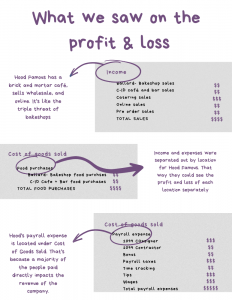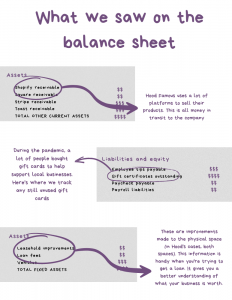Who we worked with
Chera had been baking since she was young. It wasn’t until she and her husband Geo organized a Filipino-American pop up dinner in 2013 (which quickly became a monthly series) that she realized her Filipino inspired dishes were in high demand. The pair started selling their ube cheesecake wholesale for grocery stores and markets before opening their first location in 2016. Now their deserts (and more) can be found in their Hood Famous Café + Bar, and purchased on their website.
Our initial review
Chera came to us for help sorting out Hood Famous’ books. The bookkeeping was well managed, but because of the pandemic they had to part ways with their previous bookkeeper.
Here’s what we noticed when we took a closer look:
- There was a high volume of transactions
- Hood Famous has two locations and is trying to keep their books separate
- There were a lot of activities: multiple banks and credit cards to look at
- Money was coming in through lots of revenue streams: cash, POS systems
- The previous bookkeeper made a few rules in QuickBooks to help automate some of the bookkeeping
- Hood famous used class tracking, a feature in QuickBooks that allows you to segment transactions. While this helped the client separate finances for both locations, it meant a lot more work for us- we had to figure out how it was being used and how to manage it moving forward
What we did
Step one: 🧐 Analyze and understand class tracking. To understand what the transactions were for and what location they came from, we had to figure out what they were being segmented to and why. Luckily, the client used separate bank accounts and credit cards for each location which made it easier to track everything down.
Step two: ⚙️ Create rules to automate categorization. Once we understood class tracking, we understood how transactions were categorized. We made rules for as many transactions as we could to auto-categorize them, which eliminated the need for us to go through and do all the transactions by hand.
Step three: 🗃 Organize the many revenue streams. Money came into the business’ bank accounts in many ways: through a POS system, in cash, online, etc. For each of these revenue streams, we had to review the transactions and recategorize them according to our chart of accounts. We created new rules to relate each of these streams to the appropriate clearing account on the balance sheet.
Step four: 📊 Run reports and identify total revenue that came in through each stream. For each of the streams we ran reports, cleaned the data, ran pivot tables and analyzed the revenue. Then we created a journal entry to capture that record.
Step five: 👀 Reconcile the bank statement against actual transactions, i.e. double check that all the transactions are there and match the bank statement.
Step six: ⏩ Create a projection that shows what Chera can expect in the next six months to a year. This projection was created specifically for her to ensure that it’s easy to use and understand and can provide valuable insight into how Hood Famous Bakeshop is expected to do in the future.
Step seven: 👯 Consult with the client. Here’s where we really get our client onto the same page. We shared our findings, provided advisory, shared our projection, and helped Chera get her business refreshed and revitalized for the future.
🔹 Pro-tip: Automation saves you time and money. Set rules for any transactions that are repeating, i.e. rent, utilities, repeat vendors, etc. That way they will automatically categorize these transactions as they come in and you’ll have more time to focus on other parts of your business.


Share this article




